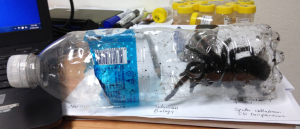Student perspective of the Uruguay Lectures
I thought I’d open the first official blog with a small discussion about the actual ‘Uruguay Lectures’ that happened in Rivera in 2018. I thought I will get a student’s perspective on these first. I therefore had a small chat with David Chamé Vázquez, who attended the lectures as a PhD student. David has since completed his PhD and started a PostDoc Position at the Centro de Investigaciones Biológicas del Noroeste in Mexico. Here’s what we said to each other.
SB: I remember the time in Rivera really well, even 4 years on, especially in revising my notes for the Silk book (see the main page of this website to purchase it). I remember the small university building that you could mistaken as a suburban house in an ordinary street in downtown Rivera. This kind of unremarkableness actually made the whole thing really cozy and friendly. We didn’t have a really big group, but they came from everywhere; Uruguay, Mexico (David), Brazil, Argentina, Peru, and Columbia if we count Luis. It was more like an informal gathering with some education happening. Hopefully high quality education. It was great. How do you guys remember the time (apart from getting locked in your room for half a day at one point)?
DCV: I enjoyed the lecture, especially the practice session. I felt comfortable as a small group member, all gathered in that small room. Even though I have studied spiders for many years, I have never observed silk thread and glue droplets through a microscope!. I still want to replicate that experience among Latin-American students. Moreover, I enjoyed seeing you extract silk of live specimens with the ingenious device (SB: as a disclaimer, the silking spool David is talking about was specifically built for use in Uruguay. I did not build it). The small talk at the dinner was the cherry on the top before returning to our hotel. To this day, when I remember Uruguay, I recall getting locked in the bathroom; it was an experience mostly funny because never happened to me something like this before…
SB: It sure was unique. From an Australian point of view, the whole immersion in the South American culture, the food and drink and discussions we had were truly amazing to me.
One thing I remember really well was doing a field trip in the back yard of the university looking for spiders and other silk making organisms, as well as one walking around the streets. Although I talked about them in my lectures, it was the first time I’d ever seen a webspinner gallery on a tree trunk, and it was pointed out to me by one of the students (I think it’s terrific when my students actually teach me stuff). The place actually seemed to be heaving with silk making organisms. What a great place for holding lectures on Silk!
How does the urban invertebrate life you saw compare to that of Mexico?
DCV: In Chiapas (Southern Mexico), many families have small backyards, and our grandmothers usually cultivate many plants, primarily ornate plants but also edibles or medicinal. These little backyards are full of spiders, web spinners, fast runners, or sit and wait spiders. I have found tiny jumping spiders, garden spiders, wolf spiders, and even the black widow and recluse spiders in my house. In recent years, there has been a decline in diversity, and now some introduced spiders are more common.
SB: Yes, invasive species, including many spiders, are becoming a huge problem around the world. Indeed one of the major research projects I did in Uruguay with researchers at the Universidad de la Republic, Uruguay, was on the impact of the invasive Australian spider Badumna longiqua on Uruguayan spiders and other aspects of its invasion, including variability in its silk properties as it changes continents (see our paper at https://www.nature.com/articles/s41598-019-49463-9).
I remember one time coming back from a collecting field trip to find this enormous tarantula in a bottle on my desk. Here is a photo of that.


